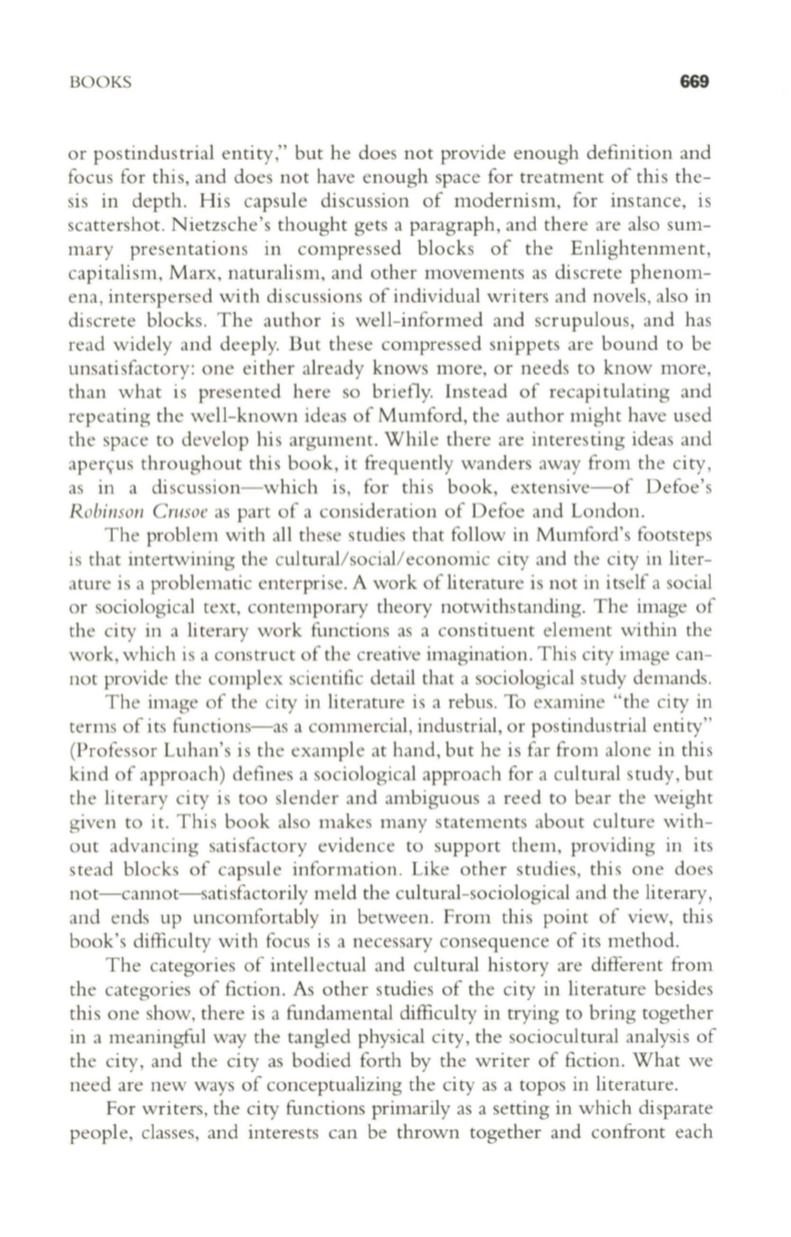
BOOKS
669
or postindustrial entity," but he does not provide enough definition and
focus for this, and does not have enough space for treatment of this the–
sis in depth. His capsule discussion of modernism, for instance, is
scattershot. Nietzsche's thought gets a paragraph, and there are also sum–
mary presentations in compressed blocks of the Enlightenment,
capitalism, Marx, naturalism, and other movements as discrete phenom–
ena, interspersed wi th discussions of individual wri ters and novels, also in
discrete blocks. The author is well-informed and scrupulous, and has
read widely and deeply. But these compressed snippets are bound to be
unsatisfactory: one either already knows more, or needs to know more,
than what is presented here so briefly. Instead of recapitulating and
repeating the well-known ideas of Mumford, the author might have used
the space
to
develop his argument. While there are interesting ideas and
aperc;:us throughout this book, it frequently wanders away from the city,
as in a discussion-which is, for this book, extensive-of Defoe's
Robinsol1 Crusoe
as part of a consideration of Defoe and London.
The problem with all these studies that follow in Mumford's footsteps
is that intertwining the cultural/social/economic city and the city in liter–
ature is a problematic enterprise. A work of literature is not in itself a social
or sociological text, contemporary theory notwithstanding. The image of
the city in a literary work functions as a constituent element within the
work, which is a construct of the creative imagination. This city image can–
not provide the complex scientific detail that a sociological study demands.
The image of the city in literature is a rebus. To examine "the city in
terms of its functions-as a commercial, industrial, or postindustrial enti ty"
(Professor Luhan's is the example at hand, but he is far from alone in this
kind of approach) defines a sociological approach for a cultural study, but
the
Ii
terary ci ty is too slender and ambiguous a reed to bear the weight
given
to
it. This book also makes many statements about culture with–
out advancing satisfactory evidence to support them, providing in its
stead blocks of capsule information. Like other studies, this one does
not-cannot-satisfactorily meld the cuI tural-sociological and the
Ii
terary,
and ends up uncomfortably in between. From this point of view, this
book's difficulty with focus is a necessary consequence of its method.
The categories of intellectual and cultural history are different from
the categories of fiction. As other studies of the ci ty in
Ii
terature besides
this one show, there is a fundamental difficulty in trying to bring together
in a meaningful way the tangled physical city, the sociocultural analysis of
the city, and the city as bodied forth by the writer of fiction. What we
need are new ways of conceptualizing the city as a topos in literature.
For writers, the city functions primarily as a setting in which disparate
people, classes, and interests can be thrown together and confront each


